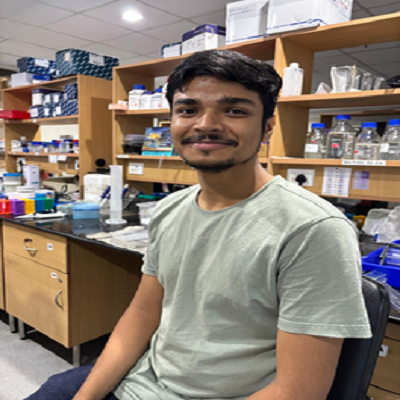
Different people react differently to the same medicine, even when they exhibit similar symptoms. This variation is primarily due to genetics. Pharmacogenomics influences how an individual's genetic makeup influences drug metabolism and response. I aim to explore the influence of pharmacogenomics on drug dosage across various populations.

Oral cancer is one of the most prevalent cancers worldwide and ranks second in incidence and mortality in India. Cancer cells adopt dramatic metabolic phenotype changes to acquire sufficient nutrients to support proliferation, cell growth, immune response, and redox homeostasis. My research interest is to understand the regulation of such metabolic remodelling that facilitates metabolic phenotype adaptation. In addition, my focus is to establish link between oral cancer genomic underpinning to the functional proteome by using mass-spectrometry based proteomic workflows that may serve as potential diagnostic/prognostic biomarkers. Read less
Read More
Globally, 25% of children < 5years suffer from growth restriction and impairment of overall development. India represents one-third of the global burden (38.4% born annually). Despite its high prevalence, biological and other associated factors that can lead to this condition are poorly understood. My research interest is focused on studying the impact of breastfeeding practices in the change in composition and diversity of the infant gut microbiome within the first 1 year of life and identifying the dysbiotic taxa along with their differentially enriched biosynthetic pathways that are associated with impaired child growth and development. The host-microbiome crosstalk will be investigated by a multi-omics approach and the contribution of both infant and maternal factors will be evaluated for their role in child growth impairment. Read less
Read More
Tuberculosis (TB) is primarily an infection of the lungs caused by Mycobacterium tuberculosis complex (MTBC). This complex comprises of upto seven Mycobacterium species including but not limited to Mycobacterium tuberculosis (M.tb) and M. bovis. This disease is a major public health burden for the country with India accounting for 27% of the world TB cases. This strain on the health care system is further compounded by the emergence of drug resistance. Multi-drug resistant (MDR)-TB is the resistance against at least two first line drugs: Isoniazid (INH) and Rifampicin (RIF). Resistance to standard antibiotic therapy allows for the drug-resistant M.tb to linger longer in the host and induce immunopathological changes which may differ from those caused by its drug-susceptible counterparts. The common determinants for developing drug resistant TB have been identified to include non-adherence to therapy, inadequate drug regimens, drug metabolism and immunological state of the host. Host genetic factors have been known to modulate drug metabolism genes. This has been exemplified in the studies regarding the NAT2 genotypes which are associated with the rates of acetylation of isoniazid. This clearly indicates at the involvement of host genetic factors in susceptibility to MDR-TB. The primary objective of my research is to explore the host genomics and functional genomics to dissect TB susceptibility and to determine host genetic basis of emergence of drug resistance. In doing so, I am studying the involvement of host genetic variants in susceptibility to drug resistant and drug sensitive TB cases through genome wide genotyping followed by identification of associated variants including variants in drug metabolism genes and validating these via targeted re-sequencing. Simultaneously in the functional genomics aspect, I am looking into the whole transcriptome to identify a gene signature which discriminates drug resistant and drug sensitive TB cases.
Read less Read More
The overarching goal of my research is to study the ancestry of Indian populations, mainly the Ancestral South Indians (ASI) and the admixture of ASI with other populations. The early migration and ancestries of Indian populations are hugely debated and there is a lack of consensus on important issues. I will use advanced statistical methods, simulation studies and genomic data to gain fur ther insight into the peopling of India. I will also look at the ancient gene flow from East and Southeast Asia into South Asia and ideally connect that to the ‘Out-of-Africa’ migration of anatomically modern humans. I want to create new statistical methods for this purpose, as required, to supplement the existing methodology.
Read less Read More
JMJD6 has diverse enzymatic activities including histone arginine demethylation, lysyl hydroxylation, and is recently shown to phosphorylate proteins. It’s high expression is robustly associated with poor prognosis in breast cancer. JMJD6 binds RNA but lacks a DNA binding domain. However, by interacting with other transcription factors like BRD4, it was recently shown to regulate the ant i-pause release of RNA pol-II on poised sites. To determine its complete function in tumorigenesis, we have haveperformed mass spectrometric analysis of proteins immunoprecipitated using JMJD6 specific antibodies. Many transcription and DNA binding factors were found and one such protein was Y-box interacting protein 1 (Ybox-1), a transcription factor that has both DNA and RNA binding activities. This protein is also associated with poor prognosis and metastasis in breast cancer. We hypothesize that JMJD6 and Ybox1 may physically interact and influence gene expression to promote breast cancer progression leading to poor patient survival. Exploring these molecular mechanisms forms the basis of my thesis. In the long run, this may steer us towards developing effective drugs against advance breast cancer.
Read less Read More
Squamous cell carcinoma of the oral cavity accounts for the top-most cancer-related mortality among men and sixth-most among women in India (GLOBOCAN-2020) due to rampant tobacco usage. Majority of oral cancer is detected at an advanced stage contributing to frequent treatment failure (recurrence, metastasis etc.) and poor disease-free-prognosis of the patient. Our recent multi-omics study (Ghosh A et al., Journal of Pathology, 2022) identified signatures of tumour initiation and progression from oral precancerous lesions. Although the genomic underpinnings of post-treatment oral cancer recurrence are not heavily explored. Our data shows a subset of patients (~25%) come back with loco-regional-recurrence; sometimes within 1 year. The primary objective of my PhD-thesis is to understand the genomic and immunological underpinnings contributing to “early-recurrence” through comparative analysis of omics assays from – tumour and normal tissue samples - from oral cancer patients having (a) early and (b) late or no-recurrence; it will help in early patient stratification and informed clinical management. Read less
Read More
Neurodegeneration often is a consequence of accumulation of misfolded aggregated proteins in different areas of the brain that further leads to cell death and inflammation. This aggregation is mainly attributed to defects in the protein clearance system, predominantly in the endo-lysosomal pathway. Normal functioning of the endo-lysosomal pathway is critical in maintaining cellular homeostasis. S everal neurodegenerative diseases like Alzheimer’s Disease (AD), Parkinson’s Disease (PD), Frontotemporal dementia (FTD), etc have been found to be caused as a result of a defective endo-lysosomal pathway. These perturbations in the functioning of the endo-lysosomal pathway are known to occur long before the occurrence of disease phenotype. My research aims at finding genetic variations and novel prognostic genomic markers in regions of increased homozygosity that are specific to the Indian population within the genes involved in the endo-lysosomal pathway. I will also be exploring the mechanistic role of TMEM106B, a lysosomal transmembrane protein that is associated with risk of numerous neurodegenerative conditions. Read less
Read More
Oral squamous cell carcinoma (OSCC) is a major cancer type globally and the most common form of cancer in men in India. Oral submucous fibrosis (OSMF) is one of the most prevalent chronic, disabling condition of the oral mucosa and 7-30% of OSMF cases can lead to malignancy in the oral cavity. The transition from pre-malignant lesions and disorders to OSCC is a continuous process of genetic a nd histologic modifications that lead to malignant transformation which is yet to be delineated. Although much data on oral cancers have been generated by bulk genomic studies, the transcriptomic triggers of this progress from OSMF to OSCC is yet to be established. I am working on single cell RNA-sequencing to gain insights into the entire tumour ecology, including intratumoral and intertumoral heterogeneity, as well as cellular interactions that may play a critical role in in this process. Such information can facilitate early triaging of OSMF cases at risk of malignancy and hence reduce occurrences of OSCC. Read less
Read More
Fatty liver disease among the non-alcoholic individuals or NAFLD is the most common chronic liver disease. Initial stage of the NAFLD is benign i.e., simple steatosis but when it progresses to advanced stages such as NASH or cirrhosis it may lead to hepatocellular carcinoma. NAFLD is a heterogenous disease - age, sex, ethnicity, environmental factor, genetic, epigenetics, metabolic health and mic robiota all are dynamically interact with each other and orchestrate disease progression. It is considered as hepatic manifestation of metabolic syndrome and is associated with the risk factors - obesity, T2DM and dyslipidaemia. Imbalance in the intake of calorie and its utilization can lead to ectopic fat accumulation in the liver. What are the exact differences in between NAFLD individuals and the fatty liver individuals with metabolic dysregulation unclear yet. My research is focused on the study the bidirectional interplay between fatty liver and metabolic alteration. Read less
Read More